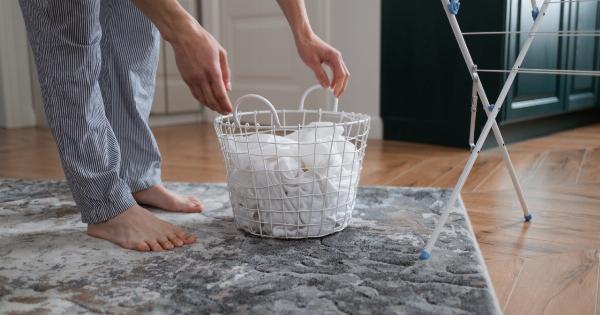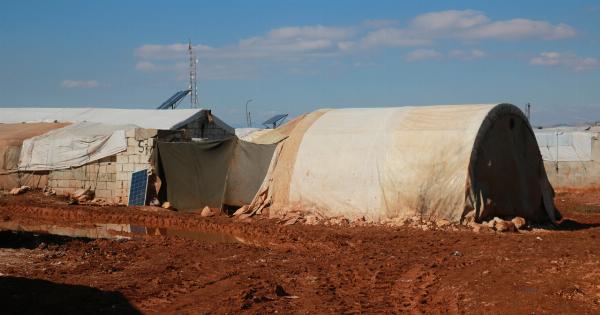Drying clothes is a mundane task that most of us carry out without giving it much thought. Whether it’s due to inclement weather or lack of outdoor space, many people resort to drying their clothes indoors.
However, what may seem like a harmless convenience can actually be dangerous to your health and safety. In this article, we will explore the potential risks and hazards associated with drying clothes inside your home.
1. Fire Hazards
One of the biggest dangers of drying clothes indoors is the increased risk of fire. When clothes are hung to dry, they release moisture into the air, which can accumulate over time.
This excess moisture can create a breeding ground for mold and mildew, and if combined with heat sources such as radiators or space heaters, it can lead to a fire hazard. The heat from these sources can cause the clothes to ignite, resulting in a potentially catastrophic blaze.
2. Increased Humidity
Drying clothes indoors can significantly increase the humidity levels in your home. If your living space is not adequately ventilated, the excess moisture from the drying clothes can cause dampness and condensation on walls, ceilings, and windows.
This moisture can lead to mold growth, which can trigger allergies and respiratory problems, particularly in individuals with asthma or other respiratory conditions.
3. Indoor Air Quality
When clothes are air-dried indoors, they release pollutants and particulate matter into the air. These pollutants can include dust, pet dander, pollen, and even chemicals from laundry detergents or fabric softeners.
In poorly ventilated areas, these airborne particles can become trapped, leading to compromised indoor air quality. Prolonged exposure to these pollutants can result in respiratory irritation, allergies, and other health issues.
4. Risk of Carbon Monoxide Poisoning
Drying clothes indoors using gas-powered dryers or hanging them near gas appliances can pose a serious risk of carbon monoxide poisoning.
Gas dryers produce carbon monoxide, a colorless and odorless gas that can be fatal if inhaled in high concentrations. Additionally, gas appliances such as water heaters or furnaces can release carbon monoxide into the air, which can further accumulate when combined with moist air from drying clothes indoors.
It is crucial to ensure proper ventilation and avoid drying clothes near gas-powered appliances.
5. Electrical Hazards
Another potential danger of drying clothes indoors is the increased risk of electrical hazards. Improper use of electric clothes dryers or the use of makeshift dryers can lead to overloaded electrical circuits, short circuits, or even electrical fires.
It is essential to follow manufacturer’s instructions, regularly maintain and inspect electrical appliances, and avoid using extension cords or adapters that may not be suitable for high-power appliances.
6. Structural Damage
Excess moisture from drying clothes indoors can lead to structural damage to your home. Moisture can seep into walls, ceilings, and floors, causing them to weaken or warp. This can result in costly repairs and compromises the integrity of your home.
Furthermore, if you live in an apartment or shared building, excessive moisture can affect neighboring units and lead to disputes or legal issues.
7. Odor and Stains
Drying clothes indoors without proper ventilation can lead to lingering odors and stubborn stains. The moisture released from the clothes can make your home smell musty or damp, which can be difficult to eliminate.
Additionally, if the clothes are not dried properly or if they are hung on surfaces that are not adequately protected, they can leave stains on walls, ceilings, and furniture.
8. Increased Energy Consumption
Drying clothes indoors can significantly increase your energy consumption. When clothes are air-dried inside, it can take longer for them to dry compared to using a clothes dryer.
This extended drying time can lead to higher energy bills, especially if you rely on electrical heating sources or dehumidifiers to aid in the drying process. Additionally, if your living space becomes excessively humid, it may also require additional energy to cool or dehumidify the area.
9. Impact on Indoor Aesthetics
Drying clothes indoors can have a negative impact on the aesthetics of your living space. Clothes hanging from radiators, shower rods, or makeshift drying racks can make your home appear cluttered and unkempt.
This can be particularly challenging if you are hosting guests or trying to maintain a tidy living environment.
10. Alternative Solutions
Although drying clothes indoors can be risky, there are alternative solutions that can help you overcome these challenges. Consider investing in a clothesline or drying rack for outdoor use when weather permits.
If you have limited outdoor space, explore options such as community laundromats or seeking permission from your landlord to install a clothesline in a communal area. Additionally, modern energy-efficient clothes dryers can help reduce drying time and energy consumption, making them a safer and more convenient option than drying clothes indoors.
Conclusion
Drying clothes indoors may seem harmless, but the potential dangers and risks associated with this practice should not be overlooked.
From fire hazards and compromised indoor air quality to increased energy consumption and structural damage, the consequences can be severe. It is important to prioritize safety and consider alternative drying methods that are suitable for your living situation.
By being aware of the risks and taking necessary precautions, you can ensure the safety of your home, protect your health, and maintain a comfortable living environment.































